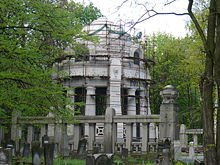
Izrael Poznanski
Encyclopedia

Aleksandrów Lódzki
Aleksandrów Łódzki - is a town in Łódzkie Voivodship and belongs to Łódź agglomeration. According to data gathered on 20 May 2002, the town had a population of 20 220.- History :...
; d. 1900 in Łódź, Poland
Poland
Poland , officially the Republic of Poland , is a country in Central Europe bordered by Germany to the west; the Czech Republic and Slovakia to the south; Ukraine, Belarus and Lithuania to the east; and the Baltic Sea and Kaliningrad Oblast, a Russian exclave, to the north...
) was a textile
Textile
A textile or cloth is a flexible woven material consisting of a network of natural or artificial fibres often referred to as thread or yarn. Yarn is produced by spinning raw fibres of wool, flax, cotton, or other material to produce long strands...
magnate
Magnate
Magnate, from the Late Latin magnas, a great man, itself from Latin magnus 'great', designates a noble or other man in a high social position, by birth, wealth or other qualities...
and philanthropist
Philanthropist
A philanthropist is someone who engages in philanthropy; that is, someone who donates his or her time, money, and/or reputation to charitable causes...
in Łódź, and the husband of Elenora Hertz Poznański.
One of the most eminent entrepreneurs in the Russian-dominated part of Poland, Poznański was the son of a Jewish merchant of Kowal
Kowal
Kowal is a town in Włocławek County, Kuyavian-Pomeranian Voivodeship, Poland, with 3,478 inhabitants .The town is the birthplace of Casimir III, King of Poland .Kowal is also a common last name in the Ukraine, which means Smith....
, who built up a textile empire and became, next to Karl/Karol Scheibler, the most important manufacturer of Łódź, a 'multicultural' city mainly populated by Poles (Catholic and Jewish) and Germans. The bourgeoisie
Bourgeoisie
In sociology and political science, bourgeoisie describes a range of groups across history. In the Western world, between the late 18th century and the present day, the bourgeoisie is a social class "characterized by their ownership of capital and their related culture." A member of the...
of these groups was described in Reymont's novel about Łódź The Promised Land
The Promised Land
The Promised Land is a 1975 Polish film directed by Andrzej Wajda, based on a novel by Władysław Reymont. Set in the industrial city of Łódź, The Promised Land tells the story of a Pole, a German, and a Jew struggling to build a factory in the raw world of 19th century capitalism.Wajda presents a...
(Ziemia Obiecana), later filmed by Andrzej Wajda
Andrzej Wajda
Andrzej Wajda is a Polish film director. Recipient of an honorary Oscar, he is possibly the most prominent member of the unofficial "Polish Film School"...
.
Since 1989, the city of Łódź has rediscovered its industrial heritage, a unique ensemble of architecture, preserved despite two World Wars. The sites linked to Poznański's memory are among the most prominent of the city: the huge factory buildings in Ogrodowa Street; the nearby Poznański Palace, today a museum (including an exhibition about Arthur Rubinstein
Arthur Rubinstein
Arthur Rubinstein KBE was a Polish-American pianist. He received international acclaim for his performances of the music of a variety of composers...
, another 'Lodschermensch'); and Poznański's marble tomb in the Jewish cemetery, the biggest Israelite graveyard in Europe. Although Poznański was devout to the belief of his ancestors, it must be noted that the generous style of his grave monument is scarcely compatible with Jewish tradition, as that religion forbids any luxury for funerals and tombs. (From Findagrave - copied by the author.)
The mausoleum
Mausoleum
A mausoleum is an external free-standing building constructed as a monument enclosing the interment space or burial chamber of a deceased person or persons. A monument without the interment is a cenotaph. A mausoleum may be considered a type of tomb or the tomb may be considered to be within the...
of Izrael and Eleonora Hertz Poznański is probably the largest Jewish tombstone in the world. The mausoleum and mosaic
Mosaic
Mosaic is the art of creating images with an assemblage of small pieces of colored glass, stone, or other materials. It may be a technique of decorative art, an aspect of interior decoration, or of cultural and spiritual significance as in a cathedral...
covering the inside of the dome were restored in 1993.
Further reading
- More about Poznanski's Łódź can be found here.
- Döblin'sAlfred DöblinAlfred Döblin was a German expressionist novelist, best known for the novel Berlin Alexanderplatz .- 1878–1918:...
Reise in Polen(about the Jewish Łódź of the 1920s).(German)

